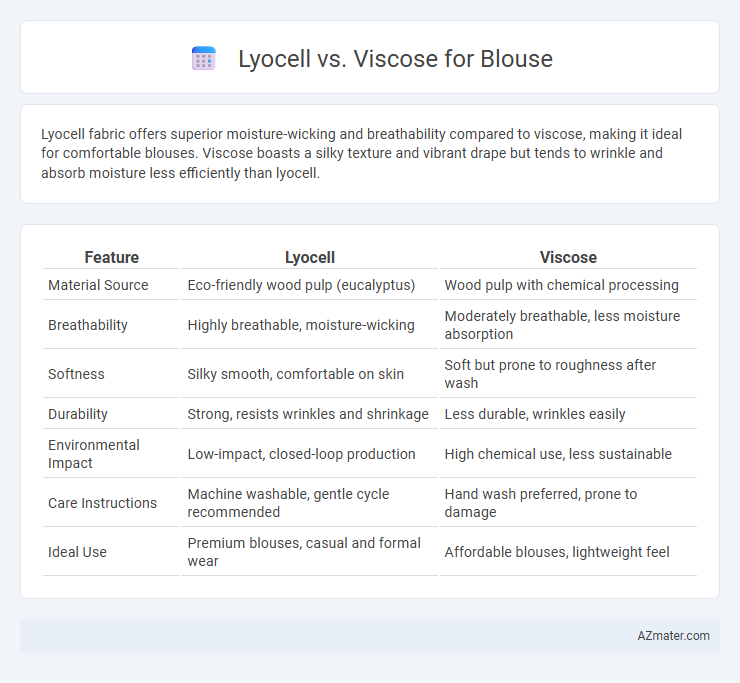Lyocell fabric offers superior moisture-wicking and breathability compared to viscose, making it ideal for comfortable blouses. Viscose boasts a silky texture and vibrant drape but tends to wrinkle and absorb moisture less efficiently than lyocell.
Table of Comparison
| Feature | Lyocell | Viscose |
|---|---|---|
| Material Source | Eco-friendly wood pulp (eucalyptus) | Wood pulp with chemical processing |
| Breathability | Highly breathable, moisture-wicking | Moderately breathable, less moisture absorption |
| Softness | Silky smooth, comfortable on skin | Soft but prone to roughness after wash |
| Durability | Strong, resists wrinkles and shrinkage | Less durable, wrinkles easily |
| Environmental Impact | Low-impact, closed-loop production | High chemical use, less sustainable |
| Care Instructions | Machine washable, gentle cycle recommended | Hand wash preferred, prone to damage |
| Ideal Use | Premium blouses, casual and formal wear | Affordable blouses, lightweight feel |
Introduction to Lyocell and Viscose Fabrics
Lyocell is a sustainable fabric made from wood pulp, renowned for its softness, breathability, and moisture-wicking properties, making it ideal for blouses. Viscose, derived from cellulose fibers like wood pulp or bamboo, offers a silky texture and vibrant draping but tends to be less durable and more prone to shrinkage than Lyocell. Both fabrics provide excellent comfort and style, but Lyocell's eco-friendly production and enhanced durability make it a preferred choice for high-quality blouses.
How Lyocell and Viscose Are Made
Lyocell is produced through a closed-loop process that dissolves wood pulp in a non-toxic solvent, making it an eco-friendly choice. Viscose is created by chemically treating wood pulp with sodium hydroxide and carbon disulfide, resulting in a less sustainable production with harmful byproducts. This fundamental difference in manufacturing directly affects the environmental impact and texture of blouses made from each fiber.
Environmental Impact: Lyocell vs Viscose
Lyocell production utilizes a closed-loop process that recycles almost 99% of its solvents, significantly reducing environmental pollution compared to viscose, which involves toxic chemicals like carbon disulfide that contribute to air and water contamination. Lyocell fibers are biodegradable and sourced from sustainably managed eucalyptus forests, promoting responsible forestry practices, whereas viscose often relies on non-organic wood sources and has a higher carbon footprint due to its energy-intensive manufacturing process. Choosing lyocell over viscose for blouses supports eco-conscious fashion by minimizing hazardous chemical exposure and conserving natural resources.
Comfort and Breathability Compared
Lyocell offers superior moisture-wicking properties and enhanced breathability compared to viscose, making it ideal for comfortable blouses in warm weather. Its smooth fibers provide a soft, silky feel against the skin while reducing irritation and overheating. Viscose, although breathable, tends to retain more moisture and may feel heavier and less cooling during prolonged wear.
Durability and Longevity Factors
Lyocell offers superior durability and longevity for blouses due to its stronger fiber structure and resistance to tearing compared to viscose, which tends to weaken after repeated washing. The sustainable closed-loop production process of lyocell also contributes to fabric resilience, maintaining softness without compromising strength. Viscose blouses, while soft and breathable, generally have a shorter lifespan because of their lower resistance to abrasion and shrinkage under frequent use.
Appearance and Texture Differences
Lyocell blouses exhibit a smooth, slightly lustrous finish with a soft, silky texture that drapes elegantly, offering a refined appearance ideal for sophisticated styles. Viscose blouses typically present a more matte look with a fluid drape and a slightly heavier, cotton-like feel that can vary in softness depending on the weave. The natural sheen and crispness of lyocell contribute to a polished, modern aesthetic, while viscose provides a cozy, breathable texture suited for casual or vintage-inspired garments.
Care and Maintenance Requirements
Lyocell blouses require gentle machine washing or hand washing in cold water to maintain fabric strength and prevent shrinkage, whereas viscose demands more delicate care, often recommending hand washing and avoiding high heat during drying to prevent fabric distortion. Both materials benefit from air drying over tumble drying, but viscose is notably more prone to wrinkling and may require low-heat ironing. Proper care extends the lifespan and maintains the soft texture of Lyocell and the smooth drape of viscose blouses.
Hypoallergenic and Skin-Friendly Properties
Lyocell fibers are highly breathable and moisture-wicking, making them ideal for sensitive skin, while viscose may cause irritation due to its chemical-intensive production process. Lyocell is naturally hypoallergenic and resistant to dust mites and allergens, enhancing comfort for those with allergies. Viscose, though soft, lacks the same skin-friendly and hypoallergenic qualities, making lyocell the preferred choice for blouses worn close to the skin.
Cost Comparison: Lyocell vs Viscose
Lyocell fabric generally carries a higher price point than viscose due to its environmentally friendly production process and durability benefits. Viscose is typically more affordable but may require more frequent replacement, impacting long-term costs. Choosing between lyocell and viscose for a blouse depends on balancing initial investment with fabric longevity and sustainability preferences.
Which Fabric Is Better for Blouses?
Lyocell offers superior breathability, moisture-wicking properties, and durability compared to viscose, making it an excellent choice for blouses that require comfort and longevity. Viscose, while soft and drapey, tends to wrinkle easily and is less environmentally sustainable due to its chemical-intensive production process. For blouses, lyocell provides a more eco-friendly, resilient, and comfortable fabric option, especially suitable for sensitive skin and all-day wear.

Infographic: Lyocell vs Viscose for Blouse
 azmater.com
azmater.com